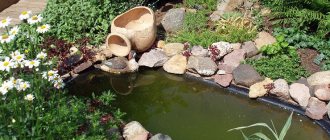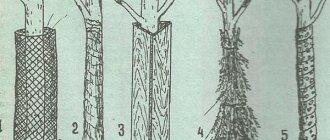The work of preparing a decorative pond for winter often frightens beginners. But this procedure is not that complicated. The main thing is to take into account the type of reservoir and properly take care of its inhabitants, in particular plants and fish.
Start preparing your pond for winter before the cold weather sets in. Before leaf fall begins, cover it with a net to prevent leaves from falling into the water. If this is not done, the leaves will soon sink to the bottom and begin to rot. As a result, they will not only spoil the beauty, but also pollute the reservoir. If leaves do end up in the pond, catch them with a net or a special water vacuum cleaner.
Cleaning the pond
Any type of pond needs thorough cleaning in the fall. After all, everything that settles at the bottom (silt, garbage, fish food) decomposes and forms pathogenic gases that can poison the inhabitants of the reservoir. The bottom is easy to clean with a rake.
If your pond is equipped with equipment (pump, filters, etc.), carefully monitor nighttime air temperatures in the fall. When the thermometer drops to 5°C, turn off all devices (if they are not equipped with special frost protection), remove them from the water, rinse, dry and store until spring in a warm and dry place.
Plastic pond
The most vulnerable body of water to low temperatures is a small one, with a surface area of two to three square meters and a depth of up to one and a half. Since there is very little water in the pond, such a home pond runs the risk of freezing through in winter. There is no need to explain that water, expanding, can damage the material from which the bottom and walls are made.
On the other hand, if all the water is drained from a small pond, then when the surrounding soil freezes, it may be compressed from the outside. The risk of distortions and deformations is especially high if the pond is not laid correctly. Therefore, a small reservoir needs to be partially drained for the winter so that the internal pressure compensates for the external pressure. A small plastic pond, as well as one made with film, must be drained and washed. Then fill 30-40% with fresh water.
Wintering a pond depending on its type
The most important question that worries summer residents is whether to pump out water in the fall or not. This depends primarily on the size of the pond.
A small reservoir (up to 20 square meters in area, up to 0.8 m deep) is considered non-wintering, because... it freezes to the bottom, and it doesn’t matter whether the pond is natural or artificial. Therefore, in the fall, all the plants are taken out of it, the fish are caught with a net, the water is pumped out, and they are sent for the winter.
The bottom and walls are cleaned manually using a brush. The pipelines are purged and sealed with foam plastic, since wood plugs can damage them when they swell in water. For the winter, such a pond is half or 2/3 filled with water. After all, at the bottom of an empty reservoir, snow and ice will still accumulate, which will take a long time to melt in the spring, but in winter the pond will only freeze from above.
In very cold winters, a hole is made in the ice and a small amount of water is pumped out through it. The resulting air cushion will prevent the pond from freezing to the bottom.
fairly large pond (with an area of over 20 sq.m and a depth of more than 1 m) only needs cleaning (with the removal of equipment) and preparing plants and fish for winter; the water does not need to be drained. If a concrete pond is properly designed and built, and its waterproofing is beyond doubt, then such a pond can be left to overwinter completely filled with water. A high-quality film pond can also be left for the winter.
Ponds of rigid shape (made of plastic or fiberglass) are sensitive to increased pressure. To prevent the pond from bursting in winter, you need to lower several plastic bottles partially filled with sand into it. In winter they will take on the pressure of the ice.
One bottle is immersed per 1 square meter of reservoir area.
If the pond is located level with the ground, water is not drained from it, but if it is raised, its level is brought to the surface of the earth.
Preservation of pond devices for the winter season
Before winter begins, it is important to preserve the equipment used in the pond. When the air temperature drops below 5 degrees, immediate shutdown and disconnection of the pumps from the filters is required. There should be no water left in the filters removed from the reservoir. Moreover, even accidental contact with rain or melt water on these devices should be prevented. In order to protect the filters from moisture, they are put away in a leak-proof room for the winter. As for their fillers, brushes and sponge fillers, they all need to be rinsed thoroughly.
In this case, it is necessary to use a weak saline solution. If the filter is dirty, it becomes ineffective. It consumes more energy and filters at low intensity. This is why thorough cleaning of the filtration system is so important. The saline solution effectively removes all contaminants from the inside and outside of this device. It removes limescale deposits that occur as a result of the filter being in the pond for a long time. It removes calcium deposits and accumulated sludge well.
When storing, pumps should be immersed in water, but they should be in a warm room. Lighting fixtures should be removed from the pond, disconnected from the electrical supply and then stored in the basement.
What to do with aquatic plants?
Another important point is the wintering of aquatic plants. Swamp and shallow-water crops are cut off almost at the root. Non-winter-hardy plants (some sedges, irises, cannas, cyperus) are removed from the pond and sent to winter in a room with a minimum of light, constantly moist soil and an air temperature of about 5 ° C.
But under no circumstances should the reed For the same purpose, you can place a bunch of delphinium stems in a pond.
Aquatic plants (water lily, yellow water lily, elodea, swamp grass, duckweed, calamus, marigold) can be left in a deep reservoir for the winter, but only if they are winter-hardy varieties. Most of them produce overwintering buds in the fall, which sink to the bottom. For insurance, a couple of buds are cut off from each plant and sent to a warm place in the house for the winter. If crops left in the pond do not survive the winter, they can be grown from these buds.
In winter-hardy aquatic plants, cut off old leaves and shoots to the root. The baskets with them are moved to the middle of the reservoir and sunk to a depth of more than 1 m. If the reservoir is shallow, all aquatic plants are removed and transferred indoors or to a deeper tank.
Heat-loving plants (water hyacinth, pistia, Nile papyrus, pontederia, marsh iris, tropical water lilies) are taken out of the pond and sent to winter in storage with dim light. There they are placed in containers with water, the temperature of which should not be lower than 10°C. The water is changed every 2-3 weeks.
Nymphs require special attention . For them, the safest way to winter is to stay in the water in the same place. But if the pond freezes, these plants are moved to the basement for the winter with an air temperature of about 5°C. The container with the nymph is placed in a spacious container with water and care is taken that it completely covers the plant.
Wintering plants
- Green plantings that grow along the edges of a reservoir or in swampy areas must be carefully cut to the water level.
- Plants that cannot tolerate winter frosts must be covered with burlap or fallen leaves. In the second case, you will need to remove the leaves in the spring to prevent them from rotting.
- Plants that are prohibited from being stored in water during frosts must be carefully removed from the reservoir without damaging their components and roots.
- All plants must be kept indoors, where the temperature is quite low, but not sub-zero. Lighting must be present, but bright light is contraindicated. In containers, you need to constantly moisten the soil at intervals that are indicated for a particular plant.
- It is recommended to leave the reed in the water without cutting it, as its tubular stems supply the water with oxygen, which is necessary for wintering fish.
Wintering fish in a pond
Changing habitat can cause severe stress in fish. Therefore, it is better if they remain to winter in their native reservoir. But this, unfortunately, is impossible if the depth of the pond is less than 1.5 m. Then the fish will freeze.
To leave living creatures for the winter, it is necessary to install special equipment in the pond (pond heaters and aerators), which will help maintain the water temperature within normal limits.
If you do not have the opportunity to purchase an aerator for a pond, you can carefully make a hole and periodically pour boiling water into this hole.
For heat-loving ornamental fish (such as cold-water trout, koi carp, goldfish, verkhovka, minnow), you should prepare a large aquarium or a spacious barrel in early autumn. Please note: for each fish up to 10 cm in length you need at least 10 liters of water with a temperature within 10-15°C. In addition, the aquarium must be equipped with a water filter and an oxygen saturation system. Decorative fish are left to overwinter indoors with a small amount of light.
Caring for wintering ponds
It is undesirable to walk on ice, and it is necessary to clear snow from it, so it is best for technical purposes, if there is no bridge, to throw a wide board across the pond.
In severe frosts, the ice is covered with straw and burlap, or roll insulation, but it cannot be kept covered for a long time - both plants and fish need light.
In extreme cold, you can drill through the ice and pump out some water, and then close the hole, creating an air cushion - it will prevent thick ice from freezing and provide oxygen to the fish. If necessary, the lack of water can be replenished later, the main thing is to add water at approximately the same temperature so as not to cause thermal shock in the fish.
A large pond in winter is very decorative and can be used as a skating rink (especially if it freezes to the bottom or, conversely, is very deep and the fish spend the winter in a hole in its deep central part). On the surface of the ice, you can create a kind of 3D masterpiece by freezing leaves, pictures, small objects or coins, and even transparent hoses with an LED garland into the ice (the decor is laid out on the ice, and then water is poured from the hose on top, so you get a transparent and voluminous composition).
Winter care of a garden pond in itself is small and not complicated, and spring re-preservation requires a minimum of effort. If you take care of your garden pond in the fall and do everything correctly, it and its inhabitants will winter easily, without loss, and will delight the owners all year round.
The process of preparing a decorative pond for the winter frightens many homeowners. Especially many questions arise for those who organize training for the first time. In fact, the process of preparing for wintering is not very complicated. First of all, it requires attentiveness, accuracy and, of course, certain physical actions, the result of which will please the owners in the spring.
Additional tricks and tricks
At the final stage of preparing the reservoir for winter, several logs or rubber balls are lowered into it. This is necessary so that the ice does not damage the walls of the pond.
During severe frosts, cover the pond on top of the ice with straw, boards or burlap. But if fish winter in it, then such a shelter cannot be left for a long time, since living organisms cannot remain without light for a long time. For the same reason, you need to regularly clean the surface of the reservoir from snow and monitor the presence of ice holes.
If in the fall you correctly carry out all the measures to prepare the pond for wintering, then it will survive the winter without much hassle or loss. And next year it will delight you again with its picturesque view.
Small tricks
To protect the pond and its inhabitants, folk protection options are often used, which do not require large amounts of money and are available to almost everyone. They are used for ponds with water in which fish spend the winter:
- It is most convenient to cover the surface of the ice with straw mats for insulation. But don’t forget to leave some light, don’t completely darken it. On the day when there is less frost, remove some of it.
- To protect against deformation, wooden logs or rubber balls are thrown into the water. When using plastic bottles, be sure to tighten the caps and scatter them at the rate of 1 container per square meter.
- Place pine paws in the hole, the surface will not freeze so quickly, then it is easy to break through it again.
You can use citric acid to clean the pump or filters from limescale. It will cope well with deposits without causing damage to the surface and rubber seals, if any.
Preparing a pond for winter on your own is not difficult if you know all the features. When pumping out water, you will have to store algae and prepare a container for fish. If the reservoir is large, then you only need to clean it and remove the equipment.
Pond cleaning
At the beginning of seasonal cooling, water temperatures begin to be measured daily. Serious preparations for winter begin when the water temperature drops to +10 ºС. At this time, the fish are fed in ever smaller quantities - they still almost stop feeding at low temperatures, and an excess of uneaten food will only lead to rotting of the water. Moreover, at this temperature, if winter heating of the water in the pond is not planned, it is already necessary to dismantle most of the equipment - aerator, pump, filter. Some pumps and filters can winter in a non-freezing pond if they are located at a depth of 50-60 cm or lower, and can even be turned on for several minutes in winter, aerating and mixing the water, so this point must be taken into account when constructing a pond.
A shallow frozen pond (less than a meter deep) is drained, manually cleaned of dirt, leaves, and silt, and the fish and plants are transferred to home aquariums . The pipes are purged and sealed with plugs, then the reservoir is filled at least two-thirds with new water. This will simplify wintering and spring defrosting. Such a pond is prepared for wintering with ice in the same way as a swimming pool - that is, the water level is adjusted in accordance with the ground level and expansion compensators are placed in the water - slightly submerged plastic canisters, 1 canister for each square meter of water surface. You can use rubber balls or several thick sheets of foam.
As a rule, preparatory work is carried out in November and early December, when the average daily air temperature ranges from zero to +5 ºС degrees. At this time, the water begins to reach its constant “winter” temperature, and fish and aquatic animals begin to settle down for the winter in their usual, natural mode. At a water temperature of +5 ºС, the reservoir is cleaned for the last time of silt (it is left only in the wintering pit), remains of dead plants, and debris. During wintering, fish need oxygen. Therefore, in winter there must be plants in the pond, and the freezing process of the reservoir will have to be controlled. When the lower layer of water cools to +4 ºС, the fish will finally stop feeding and go to the very bottom, burying themselves in the silt. Wintering will begin for them, even if the pond is not frozen. After this, it is undesirable to disturb them.
Rake with fine teeth - ideal for manually clearing the bottom of a reservoir of debris before wintering
The bottom is cleaned with a water vacuum cleaner or manually, leaves and debris are removed from the bottom using a frequent rake with rounded, flattened teeth, and then, if possible, the silt is removed. The main thing is not to overdo it - aquatic plants drop their wintering buds to the bottom in the fall. If possible, they should be left in the pond, and a few, for insurance, should be placed in the same place where the heat-loving water lilies will overwinter. In the spring, these “reserve” buds will help restore the population, even if all the other buds die. You can lower the water level in the reservoir for the few hours needed for cleaning, then it is advisable to return it back - and return the same water.
Pumping out water or protecting a reservoir
From a small, shallow reservoir, where the area is no more than 20 m² and the depth is less than 0.8 m, water must be pumped out, as it will completely freeze.
- Before the onset of cold weather, fish and plants are removed from the pool.
- The walls and bottom of the pond are thoroughly cleaned of accumulated dirt and sediment. Regular brushes are often used.
- The pipelines must be purged and securely sealed with foam. It is not recommended to use wooden plugs, as they swell in water. As they increase in volume, they can damage the pipe structure.
Before sub-zero temperatures appear, the deep pond is approximately 2/3 filled with water. Water is necessary so that snow that falls into an artificial reservoir in winter and turns into ice in spring does not delay the spring filling of the pond. If the liquid is pre-filled, ice will form only in the upper part. In the spring, a small layer of ice will quickly melt, and the winter water can be pumped out and the reservoir filled again.
If during wintering the temperature becomes too low, then a hole is made in the ice, from which the remaining water is pumped out.
The air cushion will protect the reservoir from further freezing, which will also ensure rapid melting of the ice in the spring.
If the reservoir is made manually, its concrete walls are protected by high-quality waterproofing, then pumping out the water is not necessary. If construction standards were followed when installing a film pond, then it can also be left completely filled for the winter.
Owners of molded ponds are forced to carry out a number of operations to prepare a plastic pond for the winter. Its walls can collapse from the action of frozen water, which increases in volume, turning into ice. You need to put plastic bottles and sand into such a pond, they will compensate for the pressure of the ice.










